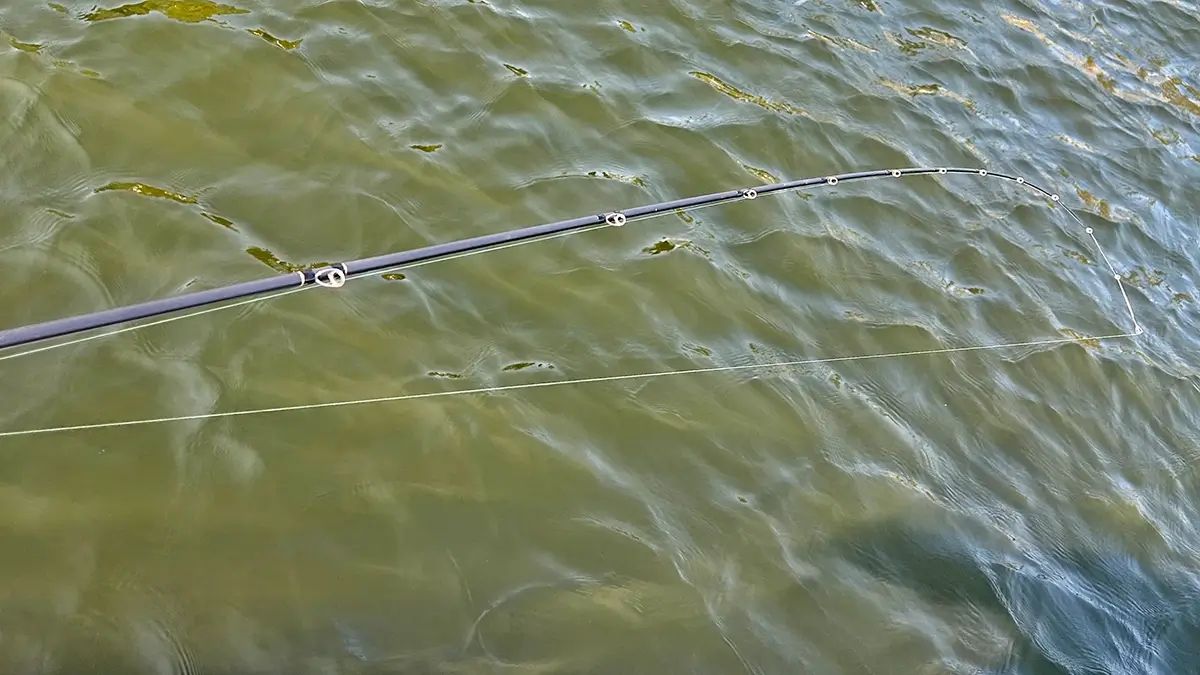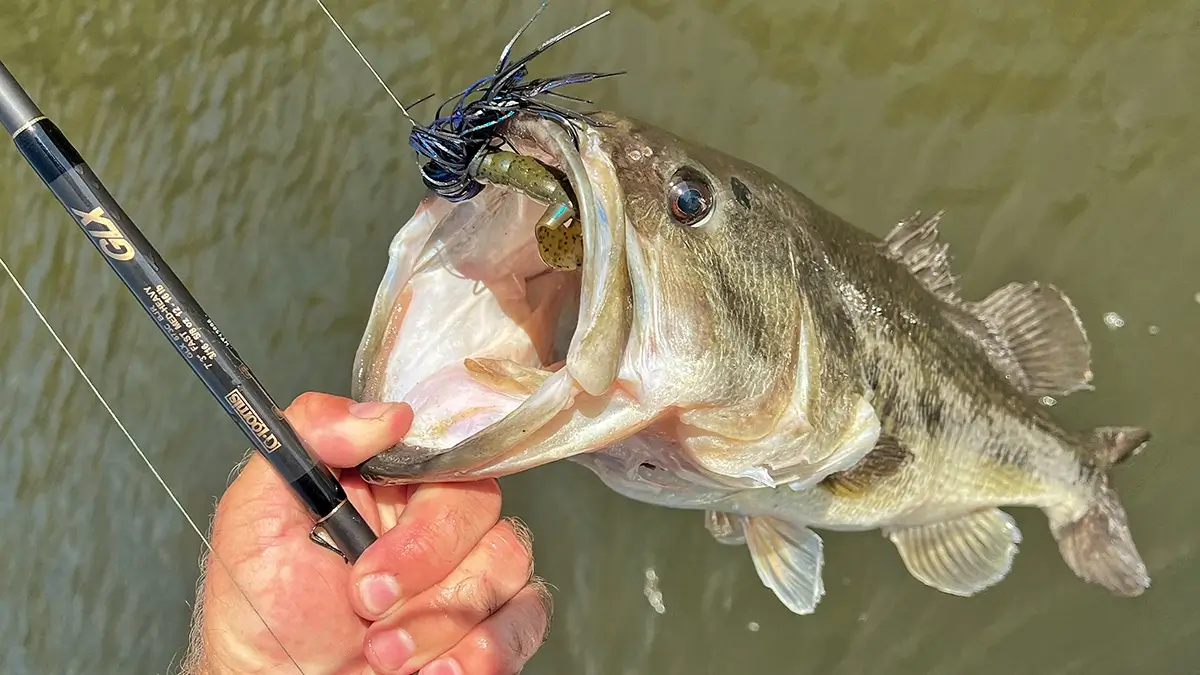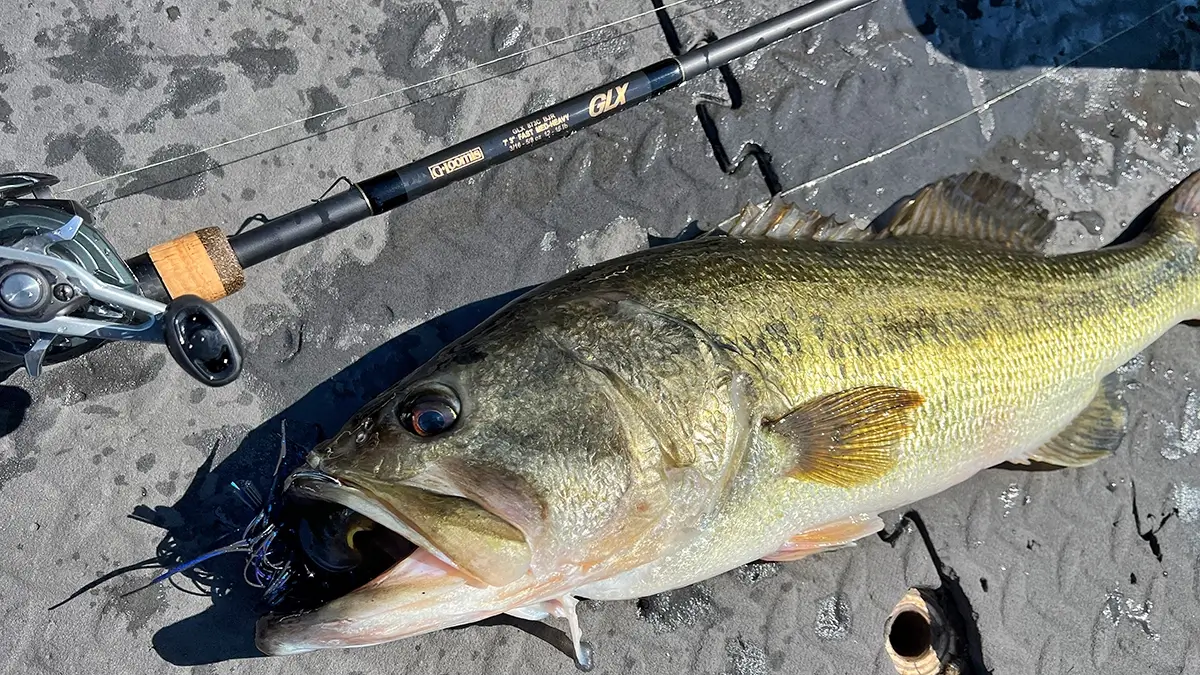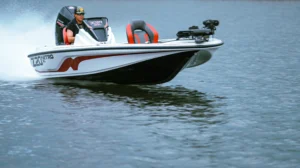G. Loomis has long been heralded as one of the premiere bass fishing rod builders in the world. With more than four decades of craftsmanship and refinement to their credit, G. Loomis continues to set the standard in many anglers’ minds for what a high-end bass rod should be capable of in their Conquest, GLX and NRX lineups.
From the moment I slid the newly redesigned GLX BASS rod out of the rod tube until my most recent cast with it, I can confidently say this is one of the nicest rods I’ve ever personally fished with; I could even see it taking over the top spot as my favorite of all-time, in time. But, you get what you pay for, and the GLX has a pretty steep price tag. Is it worth it? We’ll do our best to answer that question today as we take a deep dive into the new and improved GLX BASS Series from G. Loomis.

NEW AND IMPROVED GLX BASS SERIES
We’ll spend most of our time today reviewing one specific rod in the GLX lineup, the GLX BJR (Bladed Jig Rod). But it’s worth pointing out from the top that G. Loomis has actually revamped their entire existing GLX BASS series in 2024 (that’s 28 updated models) while simultaneously adding eight new models to the lineup (three spinning and five casting).
The GLX BASS lineup consists of 36 rods in total now; 23 casting and 13 spinning. There are 11 different handle designs spread throughout the 36 rod options. Each rod in the new and improved GLX BASS series has a tangle-free Fuji K SiC guide train, which is incorporated to improve line management and reduce overall weight.
G. Loomis also uses premium cork handles on the GLX BASS series along with custom CI4+ reel seats, which are designed to create a better point of contact between the angler and the rod blank for increased sensitivity and comfort. And each blank is made of “a proprietary blend of high-modulus graphite and advanced resin technologies,” which translates to a super light and sensitive rod.
SPECS
- Length: 7’3”
- Power: Medium-Heavy
- Action: Fast
- Pieces: One
- Rod Type: Casting
- Line Rating: 12-16 pound test
- Lure Weight: 3/16-5/8 oz
STEPPED MANDRELS AND QUALITY CORK
G. Loomis stayed true to the original GLX BASS series in several ways, including the “modern throwback” look and feel of the rods. These rods have cork grips for a traditional look and guides that are closer to “normal” size than the micro end of the spectrum.
The company has long credited the use of “stepped mandrels” for the quality and capability of their rods. The same process is still used with the revamped GLX BASS series: Engineers roll premium graphite onto a metal shaft (or mandrel) that has tiny tapering steps located at precise points to provide the perfect combination of flexibility and strength where needed.

NOT A TYPICAL BLADED JIG ROD
Now, back to the specific rod we tested for this review—the GLX BJR. G. Loomis went the unconventional route when designing their Bladed Jig Rod. Most companies these days go with a moderate or moderate-fast fiberglass rod with a parabolic bend for bladed jigs.
That’s not the case with the G. Loomis BJR, which has a fast action and medium-heavy power. This rod does have a soft tip for about the first 25% of the rod, but a whole lot of backbone after that. And that’s actually the type of rod I like to throw a ChatterBait on personally.
I have a few issues using the alternative soft rod setup with bladed jigs. For one, it’s a lot more work. The glass rods are heavier than composite casting rods and you have to snatch them aggressively to free bladed jigs from submerged vegetation and other debris. Then you have to burn the reel and make these long, sweeping hook sets to hook fish well, because the rods are so bendy. And the fiberglass rods are less sensitive too.
While some anglers actually like the glass rods (in part because they prevent them from making premature hook sets on short-striking fish), I prefer a more sensitive composite rod because it gives me a better read on what my bait is doing. I know immediately if the bait is fouled up or bogged down in cover, and then I can give a little twitch of the rod to free the bait and get the blade shaking again.
I also like to fish a ChatterBait around wood a lot, and a more responsive composite rod allows me to worm the bait through the limbs and distinguish between bites and bumps from the cover better.
With all that in mind, I believe G. Loomis built an absolutely fantastic rod for ChatterBait fishing in their BJR. It has a soft but fast tip, which makes it easy to make accurate roll casts and skips. The softness of the tip also gives you just enough cushion to distinguish a bite from a branch before setting the hook, and it allows the fish to get the bait good when they do bite. Once the hook is set, the medium-heavy power of the rod along with its length and backbone are perfectly suited for hauling big bass out of cover and flipping them in the boat.

ON THE WATER EXPERIENCE
I’ve paired this rod with a couple different reels – one spooled with braid and the other with fluorocarbon – and fished several baits on it. And that’s what I really like about the GLX BJR in comparison to other bladed jig rods, the fact that it is so versatile.
It’s no secret that this is an expensive piece of fishing gear. The chances that I would drop $550 on the typical technique-specific vibrating jig rod are minimal, simply because those soft jig rods that most companies offer aren’t suitable for any additional techniques. But, this rod is versatile and nice enough that the thought of dropping a significant chunk of change on it is at minimum more appealing.
I started out fishing a vibrating jig on this rod to really gauge its ability to fish the bait category it was designed for. I caught a handful of fish on it in the first couple trips — maybe 6 or 7. The fast tip of the rod flicked the bait out and skipped it really well, while it was also soft enough to load up on the bite and give me just enough cushion to let the fish get it before I could snatch it away from them.
I also decided to try some other baits on this rod as well. And that’s when I boated a big one. The tip of this rod along with its backbone make it the best swim jig rod that I’ve likely ever fished with. I stuck one around 5-pounds on it recently and flipped the bass right in the boat with ease. The real ticket though was how the rod performed on the bite.
I actually saw the fish come up and boil on my jig the first time and then come back and eat it on the second swipe. When I got the fish in the boat, I found the hook of my swim jig just did make it into the fish’s mouth. A stiffer rod could have easily moved my jig an inch further in the water after that initial swipe, and prevented the fish from ever reaching the bait.
The BJR also doubles as a great buzzbait rod, and I caught a couple fishing with it that way. I think it would also make a great spinnerbait rod, Plopper rod, wakebait rod, swimbait rod, casting jig rod, Texas rig rod, light football jig rod and light pitching jig rod. Basically, any technique that you like a 7’3” medium heavy/fast rod for, this is the pinnacle in that arena.
IS IT WORTH IT?
Whether any bass fishing rod is worth $550 or not is a subjective question, and ultimately it’ll be up to you to decide. I was having a hard time stomaching the idea myself. But, after doing a little research into where and how these rods are made and putting this one through the ringer on the water, I can now better understand the price tag a little. A lot goes into making these rods and they are top of the line.
There’s still plenty of room to debate whether or not a $550 rod is necessary. But as for the value of the rod, having it made by hand here in the United States in Woodland, Washington is a pretty special combination in comparison to how most other rods are manufactured. For a person with the correct change that appreciates the artistry of rod building, the GLX is a pretty easy sale. While the GLX BASS Series isn’t capable of making a bad angler good, in the right hands, this rod is perhaps the most capable I’ve ever come across.

FINAL THOUGHTS
As is the case with the majority of the products I review, this rod was sent to me to test out free of charge. And while I’d love to have a dozen of them, I’d still have a hard time dropping $550 on a rod for my personal use. But, for the avid tournament angler or guide that makes his living on the water, or someone who just loves top-of-the line fishing gear and has the funds to afford it, the GLX BASS is going to be a hard one to beat.
Simply put, the G. Loomis GLX BASS is a phenomenal rod. And the 7’3” medium heavy/fast Bladed Jig Rod in particular stands a good chance of becoming my favorite rod of all time.












